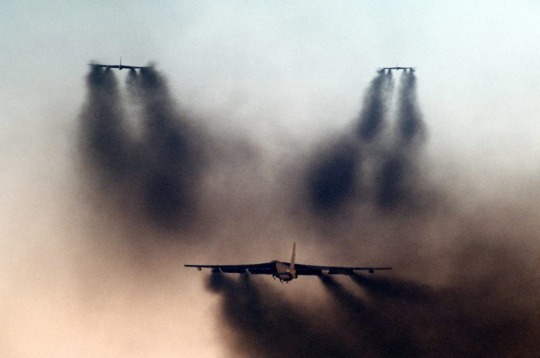#b-52
Explore tagged Tumblr posts
Text

Fortress Family
#Boeing#B-17#Flying Fortress#B-29#Superfortress#B-52#Stratofortress#Thunderbird#Doc#Buff#Bombers#warplanes#warbirds#planes#airplanes#Bomber formation#airshow
162 notes
·
View notes
Text

It is 1959, the last Convair B-36 Peacemaker lands for the last time, meanwhile somewhere in the sky a KC-135 refuels a B-52.

It is 1970, the last Convair B-58 Hustler lands for the last time, meanwhile somewhere in the sky a KC-135 refuels a B-52.

It’s 1998, the last General Dynamics F-111 Aardvark lands for the last time, meanwhile somewhere in the sky a KC-135 refuels a B-52.

It’s 2024, the last McDonnell Douglas KC-10 Extender lands for the last time, meanwhile somewhere in the sky a KC-135 refuels a B-52.

It’s 2032, the last Northrop Grumman B-2 Spirit lands for the last time…

94 notes
·
View notes
Text

B-52 Stratofortress. 70,000 lbs payload (about 23 average cars) for weapons of choice, including nukes. Fighters win fights, Bombers win wars.
265 notes
·
View notes
Text

B-52
540 notes
·
View notes
Text

The B-52’s
#The B-52's#B-52's#B52's#B- 52 's#The B 52's#B-52s#The B-52s#B52s#The B52's#B- 52's#B 52's#BC-52's#The BC-52's#The BC 52's#B.C. -52's#B-52#B 52#B52#B 52s#The B.C.52's#B - 52's#BC-52s#B.C. 52's#BC 52's#BC-52#B.52's#B'52s#B 52 'S#B-52’s#The B52s
48 notes
·
View notes
Text

Boeing B-52 Stratofortresses on the flight line.
#vintage airplane#vintage aircraft#b 52#b-52#boeing b-52 stratofortress#boeing b 52 stratofortress#military aircraft#military aviation#aviation#boeing#bombers#b-52 stratofortress#b 52 stratofortress#military bombers#cold war era#u.s. military#stratofortress#nuclear bombers#jet bombers#usaf#u.s. air force#air force#strategic air command#sac#strategic bomber
42 notes
·
View notes
Video
X-15 Launch from B-52 Mothership by NASA on The Commons Via Flickr: This photo illustrates how the X-15 rocket-powered aircraft was taken aloft under the wing of a B-52. Because of the large fuel consumption, the X-15 was air launched from a B-52 aircraft at 45,000 ft and a speed of about 500 mph. This was one of the early powered flights using a pair of XLR-11 engines (until the XLR-99 became available). The X-15 was a rocket-powered aircraft 50 ft long with a wingspan of 22 ft. It was a missile-shaped vehicle with an unusual wedge-shaped vertical tail, thin stubby wings, and unique fairings that extended along the side of the fuselage. The X-15 weighed about 14,000 lb empty and approximately 34,000 lb at launch. The XLR-99 rocket engine, manufactured by Thiokol Chemical Corp., was pilot controlled and was capable of developing 57,000 lb of rated thrust (actual thrust reportedly climbed to 60,000 lb). North American Aviation built three X-15 aircraft for the program. The X-15 research aircraft was developed to provide in-flight information and data on aerodynamics, structures, flight controls, and the physiological aspects of high-speed, high-altitude flight. A follow-on program used the aircraft as a testbed to carry various scientific experiments beyond the Earth's atmosphere on a repeated basis. For flight in the dense air of the usable atmosphere, the X-15 used conventional aerodynamic controls such as rudder surfaces on the vertical stabilizers to control yaw and canted horizontal surfaces on the tail to control pitch when moving in synchronization or roll when moved differentially. For flight in the thin air outside of the appreciable Earth's atmosphere, the X-15 used a reaction control system. Hydrogen peroxide thrust rockets located on the nose of the aircraft provided pitch and yaw control. Those on the wings provided roll control. Because of the large fuel consumption, the X-15 was air launched from a B-52 aircraft at 45,000 ft and a speed of about 500 mph. Depending on the mission, the rocket engine provided thrust for the first 80 to 120 sec of flight. The remainder of the normal 10 to 11 min. flight was powerless and ended with a 200-mph glide landing. Generally, one of two types of X-15 flight profiles was used: a high-altitude flight plan that called for the pilot to maintain a steep rate of climb, or a speed profile that called for the pilot to push over and maintain a level altitude. The X-15 was flown over a period of nearly 10 years--June 1959 to Oct. 1968--and set the world's unofficial speed and altitude records of 4,520 mph (Mach 6.7) and 354,200 ft (over 67 mi) in a program to investigate all aspects of piloted hypersonic flight. Information gained from the highly successful X-15 program contributed to the development of the Mercury, Gemini, and Apollo manned spaceflight programs, and also the Space Shuttle program. The X-15s made a total of 199 flights and were manufactured by North American Aviation. X-15-1, serial number 56-6670, is now located at the National Air and Space Museum, Washington DC. NASA Media Usage Guidelines Credit: NASA Image Number: E-4942 Date: 1959
31 notes
·
View notes
Video
youtube
Vietnam War Combat Aircraft, Bombers, Helicopters, And Rescue Planes. Included a rare F-4 Combat Tactics Documentary
#youtube#f4#f-4 phantom ii#f105#f 105 thunderchief#b-52stratofortress#b-52#vietnam war#veteran#veterans#history#aircraft#aviation
25 notes
·
View notes
Text

An ominous figure deaprting Fairford at sunset
139 notes
·
View notes
Text




Boeing B-52 Stratofortress conducting minimum interval takeoffs (MITO), an aircraft scramble technique designed to put as many aircraft in the sky as quickly as possible.
Gotta love those old smoky Pratt & Whitney J57 turbojets!
336 notes
·
View notes
Text
November 2024: The Frost Came
The frost finally appeared:

If you don't understand the tragic irony of this photo in the context of the recent election in the United States of America, ask me:




My old friend, the wasteland:

Where magic glitters for those not too blind to see:

My queen had spotted a crabapple tree while we were scouting fishing spots. We went back to harvest the fruit:

On the run:

Can you still see me?:

Maybe you aren't a bad human:

Random thing seen while walking - someone's homemade B-52 hung from a tree in our local park:

#frost#garden#backyard garden#gardening#strawberry#we hang christmas lights#immigrant workers#rail cars#graffiti#storm trooper#the wasteland#crabapples#bird#robin#american robin#random thing#seen while walking#b-52#life in memphis
11 notes
·
View notes
Text

B-52 - Food Fantasy
6 notes
·
View notes
Text
"the man with the x-ray eyes" by bauhaus is kind of just goth rock lobster
#/extremely affectionate#kittyposting#kitty posts from college#goth woman#bauhaus#goth rock#goth goth#goth#b-52#b-52s#b-52's#rock lobster
5 notes
·
View notes
Text

A Boeing B-52 Stratofortress toting a pair of AGM-28 Hound Dog cruise missiles.
#vintage airplane#vintage aircraft#b 52#b-52#boeing b-52 stratofortress#boeing b 52 stratofortress#military aircraft#military aviation#aviation#boeing#bombers#b-52 stratofortress#b 52 stratofortress#military bombers#cold war era#u.s. military#stratofortress#nuclear bombers#jet bombers#usaf#u.s. air force#air force#strategic air command#sac#agm-28 hound dog cruise missile#cruise missiles#agm-28#strategic bomber
70 notes
·
View notes

